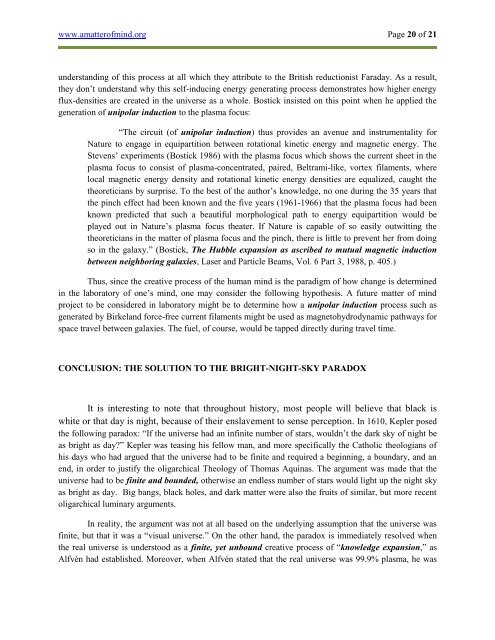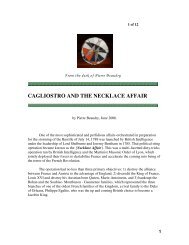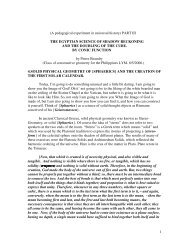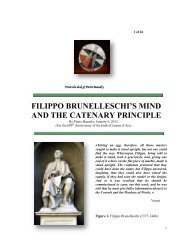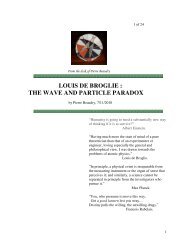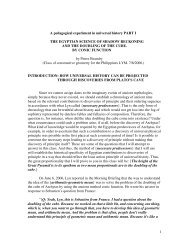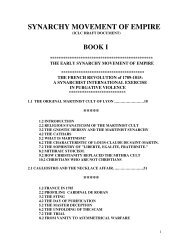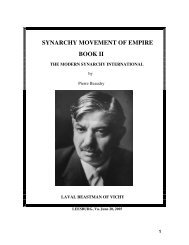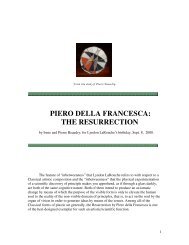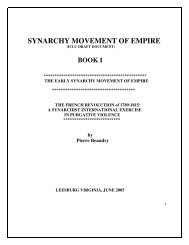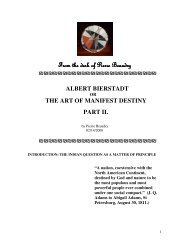THE PLASMA UNIVERSE IS A MATTER OF MIND
THE PLASMA UNIVERSE IS A MATTER OF MIND
THE PLASMA UNIVERSE IS A MATTER OF MIND
You also want an ePaper? Increase the reach of your titles
YUMPU automatically turns print PDFs into web optimized ePapers that Google loves.
www.amatterofmind.org Page 20 of 21<br />
understanding of this process at all which they attribute to the British reductionist Faraday. As a result,<br />
they don’t understand why this self-inducing energy generating process demonstrates how higher energy<br />
flux-densities are created in the universe as a whole. Bostick insisted on this point when he applied the<br />
generation of unipolar induction to the plasma focus:<br />
“The circuit (of unipolar induction) thus provides an avenue and instrumentality for<br />
Nature to engage in equipartition between rotational kinetic energy and magnetic energy. The<br />
Stevens’ experiments (Bostick 1986) with the plasma focus which shows the current sheet in the<br />
plasma focus to consist of plasma-concentrated, paired, Beltrami-like, vortex filaments, where<br />
local magnetic energy density and rotational kinetic energy densities are equalized, caught the<br />
theoreticians by surprise. To the best of the author’s knowledge, no one during the 35 years that<br />
the pinch effect had been known and the five years (1961-1966) that the plasma focus had been<br />
known predicted that such a beautiful morphological path to energy equipartition would be<br />
played out in Nature’s plasma focus theater. If Nature is capable of so easily outwitting the<br />
theoreticians in the matter of plasma focus and the pinch, there is little to prevent her from doing<br />
so in the galaxy.” (Bostick, The Hubble expansion as ascribed to mutual magnetic induction<br />
between neighboring galaxies, Laser and Particle Beams, Vol. 6 Part 3, 1988, p. 405.)<br />
Thus, since the creative process of the human mind is the paradigm of how change is determined<br />
in the laboratory of one’s mind, one may consider the following hypothesis. A future matter of mind<br />
project to be considered in laboratory might be to determine how a unipolar induction process such as<br />
generated by Birkeland force-free current filaments might be used as magnetohydrodynamic pathways for<br />
space travel between galaxies. The fuel, of course, would be tapped directly during travel time.<br />
CONCLUSION: <strong>THE</strong> SOLUTION TO <strong>THE</strong> BRIGHT-NIGHT-SKY PARADOX<br />
It is interesting to note that throughout history, most people will believe that black is<br />
white or that day is night, because of their enslavement to sense perception. In 1610, Kepler posed<br />
the following paradox: “If the universe had an infinite number of stars, wouldn’t the dark sky of night be<br />
as bright as day?” Kepler was teasing his fellow man, and more specifically the Catholic theologians of<br />
his days who had argued that the universe had to be finite and required a beginning, a boundary, and an<br />
end, in order to justify the oligarchical Theology of Thomas Aquinas. The argument was made that the<br />
universe had to be finite and bounded, otherwise an endless number of stars would light up the night sky<br />
as bright as day. Big bangs, black holes, and dark matter were also the fruits of similar, but more recent<br />
oligarchical luminary arguments.<br />
In reality, the argument was not at all based on the underlying assumption that the universe was<br />
finite, but that it was a “visual universe.” On the other hand, the paradox is immediately resolved when<br />
the real universe is understood as a finite, yet unbound creative process of “knowledge expansion,” as<br />
Alfvén had established. Moreover, when Alfvén stated that the real universe was 99.9% plasma, he was


